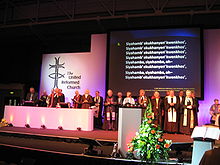- Siyahamba
-
 Singing Siyahamba with the former moderators at the United Reformed Church General Assembly 2007, Manchester
Singing Siyahamba with the former moderators at the United Reformed Church General Assembly 2007, Manchester
Siyahamba is a South African hymn that became popular in North American churches in the 1990s. The title means "We Are Marching" or "We are Walking" in the Zulu language.
Contents
History
"Siyahamba" originated in South Africa. It is said to have been composed c. 1950 by Andries van Tonder, an elder of the Judith Church.[1] The original composition was in Afrikaans (with the title "Ons marsjeer nou in die lig van God") and was subsequently translated into Zulu by Thabo Mkize. In 1978, the Swedish choral group Fjedur toured South Africa at the invitation of the Evangelical Lutheran Church of South Africa. Afterwards, Fjedur's musical director, Anders Nyberg, returned to Cape Town to record traditional choral music. It was during this year that he heard and recorded "Siyahamba" at a girls' school in Appelsbosch, Natal. Subsequently this song has been used around the world by schools in their prayers.
In 1984, Nyberg arranged "Siyahamba" for a Western four-voice setting and published it in a songbook and recording called Freedom is Coming: Songs of Protest and Praise from South Africa. In 1994, GIA Publications included the song (under the title "We Are Marching in the Light of God") in Gather Comprehensive[2], a hymnal widely used in American Catholic parishes. A year later, the United Church of Christ included the song, under the same title, in The New Century Hymnal .[3]
Today, "Siyahamba" is often performed by children's groups in both sacred and secular environments. Occasionally, the translated lyrics are modified for a secular performance: for example, the English translation "We are marching in the light of God" becomes "We are standing in the light of peace."
Lyrics
The structure of the song is cyclic, rather than sequential: the lyrics consist of one phrase, repeated with permutations. Hawn[4] notes that cyclical forms tend to emphasize a spirit of community and allow for physical response during the performance. This cyclical form, along with the meaning of the lyrics, may explain the song's popularity as a processional and offertory as well as a protest or marching song.
Afrikaans
Ons marsjeer nou in die lig van God,
Ons marsjeer nou in die lig van God.
Ons marsjeer nou in die lig van God,
Ons marsjeer nou in die lig van God.
Ons marsjeer nou, ons marsjeer nou,
Ons marsjeer nou in die lig van God.
Ons marsjeer nou, ons marsjeer nou,
Ons marsjeer nou in die lig van God.
Zulu
Siyahamba, ekukhanyeni kwenkos',
Siyahamba ekukhanyeni kwenkos'.
Siyahamba ekukhanyeni kwenkos',
Siyahamba ekukhanyeni kwenkos'.
Siyahamba, hamba, siyahamba, hamba, oh,
Siyahamba ekukhanyeni kwenkos'.
Siyahamba, hamba, siyahamba, hamba, oh,
Siyahamba ekukhanyeni kwenkos'.
Spanish
Caminamos en la luz de Dios,
Caminamos en la luz de Dios.
Caminamos en la luz de Dios,
Caminamos en la luz de Dios.
Caminamos, vamos, caminamos, vamos,
Caminamos en la luz de Dios.
Caminamos, vamos, caminamos, vamos,
Caminamos en la luz de Dios.
English
We are marching in the light of God.
We are marching in the light of God.
We are marching in the light of God.
We are marching in the light of God.
We are marching, we are marching, ooh,
We are marching in the light of God.
We are marching, we are marching, ooh,
We are marching in the light of God.
(Alternative versions of the lyrics may alternate marching with different verbs such as walking, dancing, singing, living, or praying, or the word "God" for love in a less religious gathering.)
Icelandic
Við göngum í ljósi Guðs
já, við göngum í ljósi Guðs
Við göngum í ljósi Guðs
já, við göngum í ljósi Guðs
Við göngum,
já við göngum
Úww, já ,við göngum í ljósi Guðs
Við göngum,
já við göngum
Úww, já ,við göngum í ljósi Guðs
Swahili
Twatembea nuruni mwake
twatembea nuruni mwake.
Twatembea nuruni mwake
twatembea nuruni mwake.
Twatembea tembea twatembea oho
twatembea nuruni mwake.
Twatembea tembea twatembea oho
twatembea nuruni mwake.
Portuguese
Caminhando sob a luz de Deus. Caminhando sob a luz de Deus.
Caminhando sob a luz de Deus. Caminhando sob a luz de Deus.
Caminhando, vamos. Caminhando, vamos.
Caminhando sob a luz de Deus.
Notes
- ^ CPDL, accessed March 5, 2007.
- ^ Gather Comprehensive. GIA Publications, 1994.
- ^ A New Century Hymnal. Pilgrim Press, 1995.
- ^ Hawn, C. Michael. "Singing with the Faithful of Every Time and Place: Thoughts on Liturgical Inculturation and Cross-Cultural Liturgy," Yale Institute of Sacred Music, retrieved August 5, 2006.
Categories:- Protest songs
- Hymns
Wikimedia Foundation. 2010.
